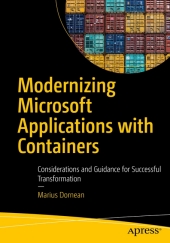 Neuerscheinungen 2020Stand: 2020-02-01 |
Schnellsuche
ISBN/Stichwort/Autor
|
Herderstraße 10
10625 Berlin
Tel.: 030 315 714 16
Fax 030 315 714 14
info@buchspektrum.de |

Marius Dornean
Modernizing Microsoft Applications with Containers
Considerations and Guidance for Successful Transformation
1st ed. 2020. xx, 280 S. 50 SW-Abb. 254 mm
Verlag/Jahr: SPRINGER, BERLIN; APRESS 2020
ISBN: 1-484-24873-2 (1484248732)
Neue ISBN: 978-1-484-24873-7 (9781484248737)
Preis und Lieferzeit: Bitte klicken
Get your legacy architecture in line with modern DevOps, monitoring, and container strategies. Lower the cost of maintaining traditional applications and benefit from aligning teams and processes.
Containerization technologies, microservice architectures, and DevOps offer numerous advantages: enhancing the software development life cycle, minimizing risks, increasing uptime, and ultimately providing more business agility. However, traditional software architectures, especially those built on Microsoft Windows using the .NET framework, are constrained in their ability to adapt these practices and techniques.
This book provides you with a prescriptive approach to containerizing traditional software offerings built on the Microsoft Windows .NET framework, while striving to mitigate and minimize risk to your organization. A wide range of considerations are covered, with the goal of teaching you about the secondary and tertiary impacts of an incremental re-architecture strategy. Topics such as monitoring, DevOps culture requirements, container orchestration, and much more are covered.
What You´ll Learn
Understand the problems large enterprises face when considering a software as a service (SaaS) strategy that includes containers and microservices
Benefit from hands-on prescriptive guidance to tackle your first containerization transition and any accompanying DevOps adoptions
Acquire valuable knowledge for organizations running Windows workloads with practical case studies
Assess the benefits offered by microservices, DevOps, and containerization architectures for your enterprise
Who This Book Is For
Enterprise developers who work with Microsoft-based .NET products or are tasked with supporting legacy N-tier Microsoft software and want to introduce the benefits of containerization with minimal risk
Chapter 1, Understanding Agile Chapter Goal: Give the reader a refresher on agile methodologies and how they support business agility. - History - General Principles - Benefits - Differences between agile and traditional (Waterfall) development
Chapter 2, DevOps 101 Chapter Goal: Provide the reader with an understanding of how DevOps supports business agility, an agile SDLC, and shorter feedback cycles with lower risk. The chapter will support the thesis that DevOps is a natural evolution from Agile to allow the whole org to deliver quickly and reliably. - History - General Principles - Feedback loops - Toolchains
Chapter 3, Containers Chapter Goal: Discuss how container technologies have evolved to supports an agile, devops focused organization. What containers are, how they are different from virtual machines, and how their elastic orchestration can equal true operational agility. - History - General Principles - Containers on Microsoft Windows - Orchestration of Containers
Chapter 4, Microservices Chapter Goal: Discuss what micro services are, and how they allow organizations to segment teams, manage features scope, and deliver faster and more reliably. Chapters 1-3 will allow us to further educate the user on how newly developed microservices would be deployed in a devops, containerized, agile process. - History - General Principles - Containers vs Virtual Machines - Sample Architectures - Sample migration from N-tier to microservices
Chapter 5, Legacy App Constraints Chapter Goal: Discuss some of the traditional deployment and SDLC semantics of N-tier based legacy apps on the Microsoft stack such a .NET webforms sites, windows service based workers, etc... Additionally, we will discuss how the deployment requirements of these technologies are at odds with a modern agile SDLC and how we can address them. - Legacy N-tier application architectures - Operational semantics and constraints
Chapter 6, Containerization Chapter Goal: Help the user understand how they can segment their N-tier Microsoft based offering into containerize able components. - Identifying segmentation points - Containerizing the component - Externalizing Configuration - Devops - from dev to operation
Chapter 7, Next steps Chapter Goal: Discuss how an organization can take the next steps to peel off feature functionality into standalone microservices to not only lower TCO, but to offer new features to customers via monetizeable APIs. - Creating new value - Peeling off functionality - Breaking down the monolith - Deploying in parallel
Chapter 8, Future technology roadmap Chapter Goal: Discuss feature and technologies on the horizon which can be explored further as they mature. - Future technologies and methodologies


